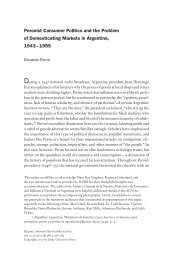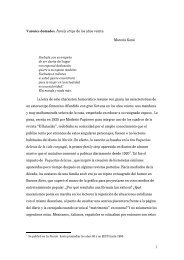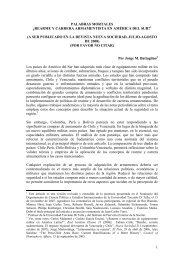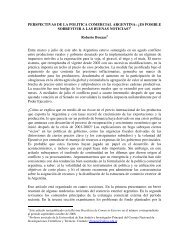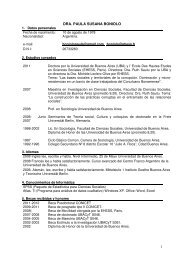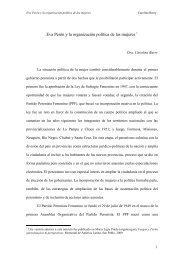Restricted mobility and fixed-mobile convergence in Brazil
Restricted mobility and fixed-mobile convergence in Brazil
Restricted mobility and fixed-mobile convergence in Brazil
You also want an ePaper? Increase the reach of your titles
YUMPU automatically turns print PDFs into web optimized ePapers that Google loves.
As noted, the regulatory framework presented a reasonably favorable environment for<br />
experimentation with new wireless technologies for STFC deployment: first, regulated<br />
<strong>in</strong>terconnection fees prevented <strong>in</strong>cumbents local carriers <strong>and</strong> long-distance carriers from<br />
suffocat<strong>in</strong>g new entrants; second, the regulator was particularly concerned with promot<strong>in</strong>g<br />
competition <strong>in</strong> the last mile; lastly, SMP frequencies were available for use by STFC entrants<br />
on a secondary basis, which m<strong>in</strong>imized spectrum acquisition costs. The comb<strong>in</strong>ation of<br />
matur<strong>in</strong>g low-cost technologies, local entrepreneurship <strong>and</strong> a supportive public policy<br />
environment created a fertile ground for Local’s growth.<br />
Regulatory tensions on the <strong>fixed</strong>-<strong>mobile</strong> frontier<br />
The case studies discussed above exemplify how the matur<strong>in</strong>g of wireless technologies for<br />
last-mile access comb<strong>in</strong>ed with regulatory <strong>in</strong>novations aimed at optimiz<strong>in</strong>g spectrum use<br />
are blurr<strong>in</strong>g the l<strong>in</strong>es between <strong>mobile</strong> <strong>and</strong> <strong>fixed</strong> telephony services, creat<strong>in</strong>g tensions as new<br />
market entrants seize opportunities <strong>and</strong> <strong>in</strong>cumbents seek protection from competition. So<br />
far, Anatel has attempted to resolve disputes with only piecemeal changes to the exist<strong>in</strong>g<br />
legal framework, thus open<strong>in</strong>g the door for market players to seek redress <strong>in</strong> the courts. The<br />
un<strong>in</strong>tended result has been lengthy judicial battles that deter <strong>in</strong>vestors <strong>and</strong> fail to resolve the<br />
substantive issues.<br />
The concept that has guided Anatel <strong>in</strong> its attempts to allow FWA/WLL for <strong>fixed</strong> services<br />
without disrupt<strong>in</strong>g the <strong>mobile</strong> market is restricted <strong>mobility</strong>. Between 2005 <strong>and</strong> 2006, Anatel<br />
issued several resolutions requir<strong>in</strong>g STFC <strong>and</strong> SCM licensees to employ equipment with<br />
restricted <strong>mobility</strong> <strong>in</strong> the 2.1, 2.5, <strong>and</strong> 3.5 GHz b<strong>and</strong>s. Nonetheless, the exact mean<strong>in</strong>g of<br />
restricted <strong>mobility</strong> was left undef<strong>in</strong>ed, <strong>and</strong> thus regulatory battles moved to the courts. This<br />
approach also created asymmetries with STFC licensees <strong>in</strong> the 1.8 <strong>and</strong> 1.9 GHz b<strong>and</strong>s,<br />
which fell outside the restricted <strong>mobility</strong> requirement.<br />
In 2007, Anatel carried out a public consultation that proposed to <strong>in</strong>corporate the terms<br />
<strong>mobility</strong> feature ( função de mobilidade) <strong>and</strong> restricted <strong>mobility</strong> ( função de mobilidade<br />
restrita) <strong>in</strong> the certification rules for digital transmitters <strong>and</strong> transceivers used by<br />
<strong>fixed</strong>-service providers <strong>in</strong> po<strong>in</strong>t-multipo<strong>in</strong>t applications <strong>in</strong> frequency b<strong>and</strong>s above 1 GHz.<br />
By prohibit<strong>in</strong>g these devices from activat<strong>in</strong>g their <strong>mobile</strong> capabilities, Anatel aimed at<br />
prevent<strong>in</strong>g new <strong>mobile</strong> broadb<strong>and</strong> technologies (<strong>in</strong> particular the <strong>mobile</strong> version of WIMAX)<br />
from be<strong>in</strong>g used by <strong>fixed</strong> telephony operators. Resolution 492, issued <strong>in</strong> February of 2008,<br />
imposed limits over <strong>mobility</strong>, roam<strong>in</strong>g <strong>and</strong> h<strong>and</strong>off-h<strong>and</strong>over capabilities of transmitters <strong>and</strong><br />
transceivers operat<strong>in</strong>g above 1 GHz. While not the ma<strong>in</strong> regulatory target, the resolution<br />
affected FWA/WLL networks such as those of Embratel <strong>and</strong> Local. The pr<strong>in</strong>ciple beh<strong>in</strong>d the<br />
resolution was that STFC operators utiliz<strong>in</strong>g FWA or WLL must absta<strong>in</strong> from mimick<strong>in</strong>g the<br />
core characteristics of SMP licensees, i.e. <strong>mobility</strong> <strong>and</strong> wide-area roam<strong>in</strong>g.<br />
Disputes about restricted <strong>mobility</strong> have also surfaced <strong>in</strong> the General Concessions Plan<br />
(PGO), arguably the central document <strong>in</strong> <strong>Brazil</strong>’s telecommunications legal edifice. The PGO<br />
specifies which telecommunication services are bound to a public service regime, among<br />
other key issues. The first PGO was enacted on April 3, 1998, <strong>and</strong> attributed a public service<br />
regime to the <strong>fixed</strong> switched telephone service (STFC) provided by the former state<br />
monopoly Telebrás. In do<strong>in</strong>g so, the PGO def<strong>in</strong>ed STFC by enumerat<strong>in</strong>g its basic<br />
characteristics: ‘‘voice <strong>and</strong> signals transmission’’, ‘‘communication between specified <strong>fixed</strong><br />
po<strong>in</strong>ts’’ <strong>and</strong> ‘‘use of telephony process’’.<br />
As part of the process of updat<strong>in</strong>g the PGO, Anatel launched a public consultation <strong>in</strong> which<br />
Embratel suggested the elim<strong>in</strong>ation of the word ‘‘<strong>fixed</strong>’’ from the def<strong>in</strong>ition of STFC. The text<br />
approved by Anatel’s Board of Directors revealed that the regulator was will<strong>in</strong>g to accept a<br />
more flexible def<strong>in</strong>ition for STFC services, but the f<strong>in</strong>al text approved by the M<strong>in</strong>istry of<br />
Communication <strong>and</strong> enacted by Presidential Decree 6654 of November 20, 2008<br />
reestablished the orig<strong>in</strong>al word<strong>in</strong>g. As a result, the current PGO still def<strong>in</strong>es STFC as a<br />
service that provides transmission of voice <strong>and</strong> signals between specified <strong>fixed</strong> po<strong>in</strong>ts<br />
through a telephony process. Although neither the previous nor the current PGO specify the<br />
mean<strong>in</strong>g of ‘‘telephony process’’ or ‘‘<strong>fixed</strong> po<strong>in</strong>ts’’, the reestablishment of the orig<strong>in</strong>al<br />
VOL. 13 NO. 1 2011 j<strong>in</strong>foj PAGE 39



